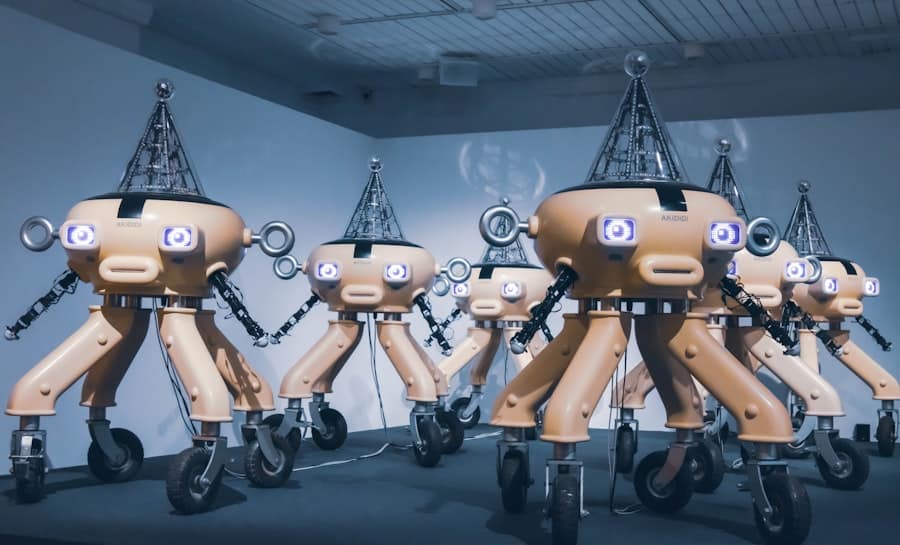Space robotics is a rapidly evolving field that merges the principles of robotics with the challenges of space exploration. As humanity’s ambitions extend beyond Earth, the need for advanced robotic systems has become increasingly apparent. These systems are designed to operate in the harsh and unforgiving environment of space, where conditions such as extreme temperatures, radiation, and microgravity present unique challenges.
The development of space robotics encompasses a wide range of technologies, including autonomous navigation, manipulation, and communication systems, all tailored to function in extraterrestrial settings. The history of space robotics can be traced back to the early days of space exploration, with missions such as the Soviet Union’s Luna program and NASA’s Mariner missions. These early robotic spacecraft laid the groundwork for more sophisticated systems that would follow.
Today, space robotics encompasses a variety of applications, from planetary exploration and satellite servicing to space station maintenance and asteroid mining. As we look to the future, the integration of robotics into our exploration efforts will be crucial for expanding our understanding of the universe and potentially establishing a human presence beyond Earth.
Key Takeaways
- Space robotics plays a crucial role in space exploration by performing tasks that are too dangerous or difficult for humans.
- Using robots in space offers advantages such as cost-effectiveness, efficiency, and the ability to withstand harsh environments.
- Challenges and limitations of space robotics include communication delays, limited dexterity, and the need for advanced autonomy.
- Successful space robotics missions include the Mars rovers, the International Space Station robotic arm, and the Hubble Space Telescope servicing missions.
- Future applications of space robotics include asteroid mining, satellite servicing, and construction of space habitats.
The Role of Space Robotics in Space Exploration
Space robotics plays a pivotal role in modern space exploration by enabling missions that would be impossible or too dangerous for human astronauts. Robotic systems can be deployed to explore distant planets, moons, and asteroids, gathering data and conducting experiments in environments that are inhospitable to human life. For instance, rovers like NASA’s Perseverance and Curiosity have been instrumental in exploring the Martian surface, analyzing soil samples, and searching for signs of past life.
These robots are equipped with advanced scientific instruments that allow them to perform complex tasks autonomously or under remote control from Earth. Moreover, space robotics is essential for the construction and maintenance of space infrastructure. The International Space Station (ISS) relies on robotic arms, such as the Canadarm2, to assist astronauts in various tasks, including the installation of new modules and the repair of equipment.
As we prepare for future missions to the Moon and Mars, the role of robotics will only expand, facilitating not only exploration but also the establishment of sustainable human habitats on other celestial bodies.
Advantages of Using Robots in Space

The advantages of employing robots in space exploration are manifold. One of the most significant benefits is their ability to operate in environments that are hostile to humans. Space is characterized by extreme temperatures, vacuum conditions, and high levels of radiation, all of which pose serious risks to human health.
Robots can be designed to withstand these conditions without the need for life support systems, allowing them to function effectively over extended periods. This capability enables missions to last longer and cover greater distances than would be feasible with human crews. Additionally, robots can perform repetitive or hazardous tasks with precision and efficiency.
For example, robotic arms can conduct delicate repairs on spacecraft or satellites without the risk of human error or injury. This precision is particularly valuable in situations where human intervention would be risky or impractical. Furthermore, robots can be equipped with advanced sensors and artificial intelligence algorithms that allow them to analyze data in real-time, making decisions based on their findings without waiting for instructions from Earth.
This autonomy is crucial for missions to distant locations where communication delays can hinder timely responses.
Challenges and Limitations of Space Robotics
Despite their many advantages, space robotics also faces significant challenges and limitations. One major hurdle is the complexity of designing robots that can operate autonomously in unpredictable environments. While advancements in artificial intelligence have improved robotic decision-making capabilities, there are still scenarios where unforeseen circumstances can arise.
For instance, a rover navigating rocky terrain may encounter obstacles that require immediate adjustments to its path. Developing algorithms that can handle such dynamic situations remains a significant area of research. Another challenge lies in the communication delays inherent in space exploration.
For missions beyond low Earth orbit, such as those targeting Mars or further destinations, signals can take several minutes to travel between Earth and the spacecraft. This latency complicates remote control operations and necessitates a high degree of autonomy for robotic systems. Engineers must design robots that can not only execute pre-programmed tasks but also adapt to changing conditions without real-time input from mission control.
Examples of Successful Space Robotics Missions
Numerous successful missions have showcased the capabilities of space robotics, demonstrating their vital role in advancing our understanding of the cosmos. One notable example is NASA’s Mars Rover program, which includes the Spirit and Opportunity rovers launched in 2003. These rovers were designed to explore the Martian surface and conduct scientific experiments over a planned mission duration of 90 sols (Martian days).
However, both rovers far exceeded expectations; Opportunity operated for nearly 15 years before its mission concluded in 2018. Another landmark mission is the Hubble Space Telescope, which has relied on robotic servicing missions to maintain and upgrade its instruments since its launch in 1990. The use of robotic systems allowed astronauts to perform complex repairs and enhancements while minimizing risks associated with human spacewalks.
The success of these missions has not only extended Hubble’s operational life but has also provided invaluable data that has transformed our understanding of the universe.
Future Applications of Space Robotics

Looking ahead, the potential applications for space robotics are vast and varied. One promising area is asteroid mining, where robotic systems could be deployed to extract valuable resources from asteroids.
Robots equipped with advanced mining technologies could operate autonomously on these celestial bodies, identifying and extracting resources without requiring human presence. Another exciting application lies in the establishment of lunar bases as part of NASA’s Artemis program and other international efforts. Robotic systems will play a crucial role in constructing habitats, deploying solar panels, and setting up life support systems before humans arrive on the Moon.
These robots will need to navigate the lunar surface’s challenging terrain while performing tasks that ensure a safe environment for astronauts when they eventually land.
The Importance of Advancing Space Robotics Technology
Advancing space robotics technology is essential for overcoming current limitations and unlocking new possibilities in space exploration. Continued investment in research and development will lead to more sophisticated robotic systems capable of performing increasingly complex tasks autonomously. Innovations in materials science could yield lighter and more durable components that enhance a robot’s ability to withstand harsh conditions while improving energy efficiency.
Moreover, advancements in artificial intelligence will enable robots to learn from their experiences and adapt their behavior based on environmental feedback. This capability will be crucial for future missions where robots must navigate unknown terrains or respond to unexpected challenges autonomously. As we push the boundaries of exploration further into our solar system and beyond, enhancing our robotic capabilities will be fundamental to achieving ambitious goals such as crewed missions to Mars or even interstellar exploration.
The Future of Space Exploration with Robotics
The future of space exploration is intricately linked with advancements in robotics technology. As we continue to push the boundaries of what is possible beyond our planet, robots will serve as our eyes and hands in environments that are otherwise inaccessible or too dangerous for humans. From exploring distant planets to constructing habitats on the Moon, the role of robotics will only grow more significant as we embark on new frontiers.
As we stand on the cusp of a new era in space exploration, it is clear that investing in space robotics technology will yield dividends not only for scientific discovery but also for humanity’s long-term aspirations beyond Earth. The integration of advanced robotic systems into our exploration efforts will pave the way for sustainable human presence on other celestial bodies while expanding our understanding of the universe’s mysteries. The journey ahead promises to be as exciting as it is challenging, with robotics at its forefront driving innovation and discovery into uncharted territories.
In the quest to expand our exploration of the cosmos, space robotics play a crucial role by enabling missions that are too dangerous or distant for human astronauts. These advanced machines can perform tasks such as collecting samples, constructing habitats, and maintaining equipment, which are essential for the success of long-term space missions. A related article that delves into the innovative spirit driving technological advancements can be found in the discussion of what we can learn from Instagram’s founders’ return to the social media scene. This article highlights the importance of creativity and resilience in technology development, principles that are equally applicable to the field of space robotics.
FAQs
What are space robotics?
Space robotics refers to the use of robotic technology in space exploration, including the design and deployment of robots for tasks such as planetary exploration, satellite servicing, and maintenance of space infrastructure.
Why are space robotics important for expanding exploration?
Space robotics are important for expanding exploration because they can perform tasks that are too dangerous or difficult for humans, such as exploring harsh environments on other planets, repairing and maintaining satellites, and building and assembling structures in space.
What are some examples of space robotics in use today?
Some examples of space robotics in use today include the Mars rovers, which have been exploring the surface of Mars for years, and the Canadarm on the International Space Station, which is used for capturing and servicing spacecraft.
How do space robotics benefit space exploration?
Space robotics benefit space exploration by enabling scientists and engineers to gather data and perform tasks in environments that are inaccessible or hazardous to humans, ultimately advancing our understanding of the universe and paving the way for future human exploration of space.
What are the challenges of developing space robotics?
Challenges in developing space robotics include designing robots that can withstand the harsh conditions of space, developing autonomous navigation and decision-making capabilities, and ensuring reliable communication with robots operating in distant locations.

